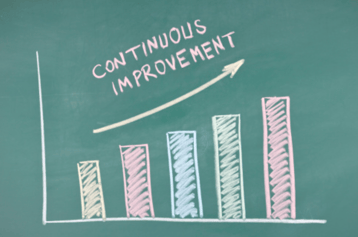Using Data to Develop a Continuous Improvement Strategy
Over the last few years, organizations have needed to make a shift from reacting in a disorganized manner when something unexpected happens to proactively addressing or responding to disruptions quickly and effectively. This approach has helped organizations to rapidly recover, thrive, and move forward, thus improving their business agility.
How are organizations accomplishing enterprise business agility?
- By prioritizing people, safety, continuous productivity, and improvement
- By reshaping strategy for business continuity—evaluating business outcomes and readjusting based on reality instead of assumptions
- By realigning the organization and delivery teams around these adjusted outcomes and short-term priorities
- By focusing on running the business, keeping operations strong, and having healthy cash reserves
- By keeping their contingency plans up-to-date
The key to doing all of the above is data. Focusing on current, relevant data to inform decisions and priorities—especially in times of uncertainty—is crucial, because it helps you focus on the right things, monitor progress, and overcome misleading assumptions.
Once you have meaningful data, utilizing it properly to develop an ongoing Continuous Improvement Strategy throughout your organization is the next pivotal step. A Continuous Improvement Strategy allows teams to optimize their maturity and performance, ensuring they can always respond to disruptions well. When enterprises are on a journey of Digital or Agile transformation, the foundation of continuous improvement needs to be strong in order to succeed.
Building Blocks for Designing a Continuous Improvement Strategy
The American Society for Quality defines Continuous Improvement as “the ongoing improvement of products, services or processes through incremental and breakthrough improvements. These efforts can seek ‘incremental’ improvement over time or ‘breakthrough’ improvement all at once.”
A continuous improvement strategy begins with asking “What do I need to measure?”. You can start by looking at the team level, move up to the team of teams level, and finally, look across the entire organization.
Quick overview of Continuous Improvement rollout steps:
- Define goals and outcomes for your measurement and continuous improvement program
- Identify the teams in the program scope, or decide to include your entire organization
- Gain consensus on what to measure at each level
- Rank and prioritize the rollout plan and develop a quarterly roadmap to monitor progress
- Enable the leadership team’s readiness to remove obstacles
- Identify change management areas of focus for teams, leaders, and stakeholders
- Define a talent development strategy for key roles that enable agility throughout the organization
Make Data-Fueled Decisions
To begin gathering the right data to fuel your decisions and understanding the current state of your teams, you need to establish a baseline, which provides you with a benchmark to measure success against. At AgilityHealth®, we offer an Org Baseline Jump Start, which is the ability to assess maturity and performance across all of your teams at once to gain insights into your teams’ current state, as well as identify strengths and areas for improvement.
Baseline data can be used to help inform investment decisions and enables you to maximize targeted areas of focus, such as talent gaps, coaching, training, etc. across all teams. The Org Baseline Jump Start gives you the ability to quickly assess a large number of teams, identify targeted recommendations for improvement, and determine which obstacles leaders need to help remove. Combining these key insights, leadership support, and access to the AgilityHealth® Growth Portal, teams are enabled to make data-fueled decisions, which helps them more quickly mature and become high-performing.

Implementing a continuous improvement cycle fosters team
maturity and performance.
Periodically repeating assessments throughout the organization allows teams to see their growth over time and keep their focus on strengths and areas to improve. Ensuring leaders support the mission to remove impediments and support team maturity and growth allows progress to be fostered, which in turn creates a culture of continuous improvement in your organization.
Continuously Improve Enterprise Agility
In 2021, we saw the need to add a certification course for those champions who are responsible for implementing and ensuring the success of continuous improvement strategies within their organization. The Continuous Improvement Champion Certification enables internal change agents with the skills needed to set up Measure & Grow programs for success and ensure managers and leaders are actioning on improvement plans so that tangible results are achieved. These change agents are usually embedded in the team responsible for the organization’s Enterprise Business Agility journey.
.png?width=202&height=213&name=CIC%20Final%20(1).png)
Embed strategists to lead your enterprise transformation by certifying change agents
with our Continuous Improvement Champion Certification.
Ultimately, a Continuous Improvement Strategy helps you develop a prioritized roadmap and holistic approach for your Digital or Agile transformation journey by measuring what matters at different levels of your organization and engaging leaders early and often to remove impediments and foster team growth. Assessing groups of teams through the Org Baseline Jump Start will identify patterns and target areas to focus on so you can use that data to drive improvements across your enterprise—and be responsive when disruptions occur, rather than reactive.
Key Resources
- Schedule a Measurement and Continuous Improvement Strategy workshop to get started with your strategy
- Enroll key strategists in our Continuous Improvement Champion Certification to help foster your strategy
- Begin developing a continuous improvement program at all levels by completing an Org Baseline



Comments